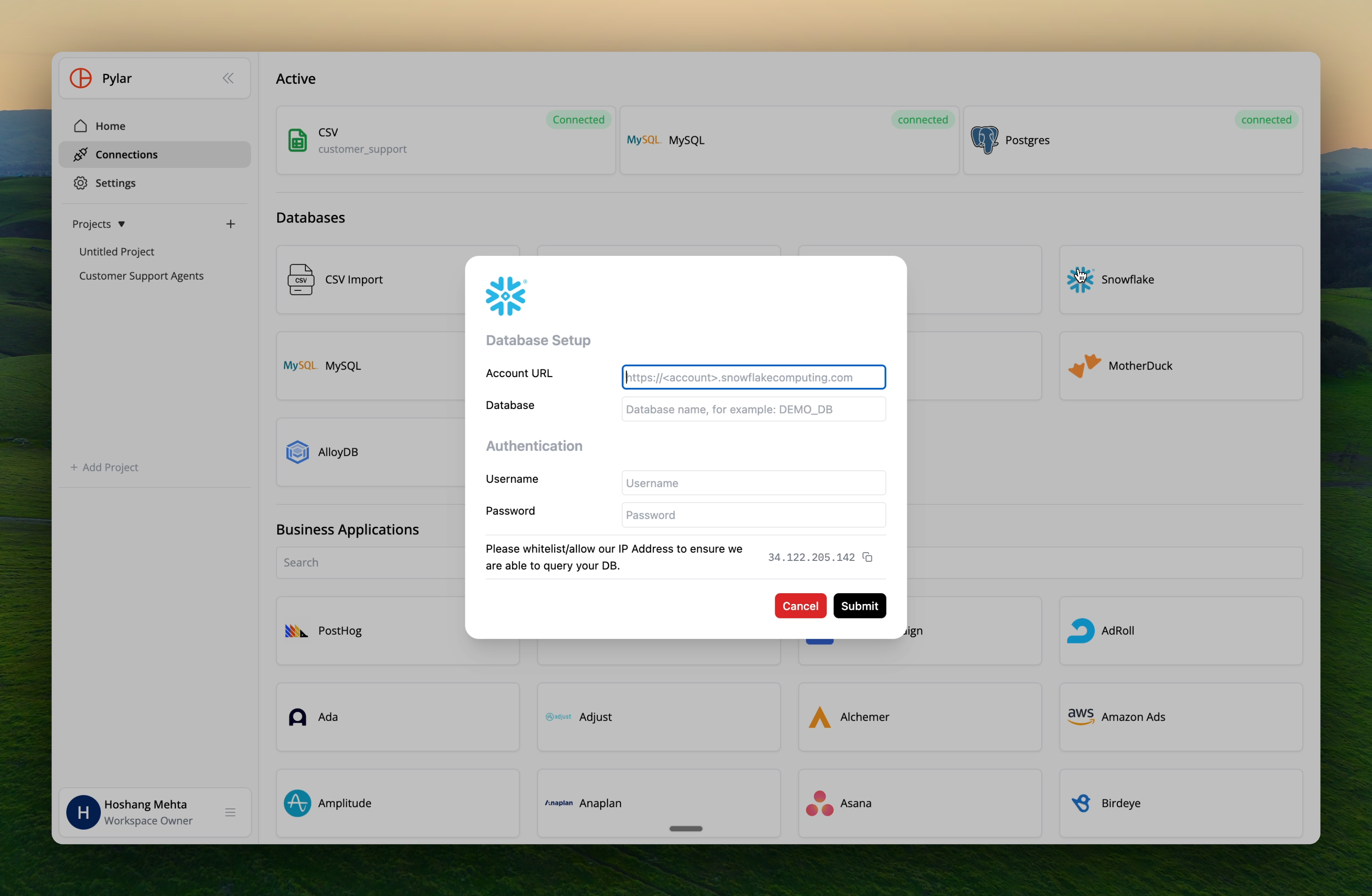Overview
Connecting Pylar to Snowflake allows you to leverage your Snowflake data for analysis and insights. Your data remains in Snowflake—Pylar indexes it for easier querying and executes queries on your Snowflake infrastructure.Prerequisites
- ✅ Pylar account with Analyst role or higher
- ✅ Snowflake account with access credentials
- ✅ Database access permissions in Snowflake
- ✅ Ability to whitelist IP addresses in Snowflake
Step 1: Prepare Your Snowflake Account
Before connecting, ensure you have:- Access to your Snowflake account
- Database credentials (username and password)
- Knowledge of which database you want to connect
- Ability to modify network policies (for IP whitelisting)
Step 2: Retrieve Snowflake Account URL
- Open your Snowflake UI in a new tab
- Log in to your Snowflake account
- Locate your account URL
https://abc12345.us-east-1.snowflakecomputing.com
Step 3: Trim the URL
Copy your Snowflake account URL and prepare it for Pylar:- Remove the
https://prefix - Remove everything after
.snowflakecomputing.com
- Original:
https://abc12345.us-east-1.snowflakecomputing.com - Trimmed:
abc12345.us-east-1.snowflakecomputing.com
Step 4: Navigate to Pylar Connections
- Switch to your Pylar workspace
- Click on the “Connections” tab located in the sidebar
- You’ll see the list of available data sources
Step 5: Select Snowflake Connector
From the list of available data sources, select “Snowflake”. The connection setup screen will open.Step 6: Enter Connection Details
Fill in the following information:
Account URL
Paste the trimmed Snowflake account URL you prepared in Step 3. Format:<account_identifier>.snowflakecomputing.com
Example: abc12345.us-east-1.snowflakecomputing.com
Database Name
Enter the name of the database you want to use. Examples:SNOWFLAKE_SAMPLE_DATA(if using sample data)PRODUCTION(your production database)ANALYTICS(your analytics database)
Username
Enter the username you use to log into your Snowflake account. Note: This should be a user with appropriate permissions to query the database.Password
Enter the corresponding password for your Snowflake account.Step 7: Whitelist Pylar IP Address
Critical Step: Whitelist Pylar’s IP address to ensure seamless connectivity. Pylar IP Address:34.122.205.142
How to whitelist in Snowflake:
- Log in to Snowflake as an administrator
- Go to Admin → Security → Network Policies
- Create a new network policy or modify an existing one
- Add
34.122.205.142to the allowed IP addresses - Apply the network policy to your account or user
- Contact your Snowflake administrator to whitelist the IP
- Or configure at the account level if you have admin access
Step 8: Test Connection
- Click the “Test Connection” button
- Pylar will attempt to connect to your Snowflake database
- If successful, you’ll see a success message
- If it fails, you’ll be prompted to correct your credentials
A successful test connection means Pylar can reach your Snowflake database and authenticate. This is a good sign that everything is configured correctly.
Step 9: Save and Connect
Once the connection test is successful:- Click “Save” or “Connect”
- You’ll be prompted to give the connection a schema name
- Enter a descriptive name (e.g.,
snowflake_productionoranalytics_warehouse) - Save the configuration
- Lowercase letters only
- Numbers and underscores allowed
- No spaces or special characters
Step 10: Wait for Ingestion
After saving:- Data indexing begins: Pylar starts indexing your Snowflake data
- Processing time: This may take a while depending on the volume of data
- Notification: You’ll receive an email notification once data ingestion is complete
If your Snowflake data doesn’t show up immediately, give it a few minutes. Large databases can take time to index. You’ll receive an email when the process is complete.
Querying Data from Snowflake
Once indexing is complete, querying data is simple:Step 1: Go to Query Section
- Navigate to the query section in your Pylar workspace
- Open the SQL IDE
Step 2: Run a Query
Enter your SQL query to fetch data from Snowflake:Step 3: View Results
Your query results will be displayed, showing how easy it is to access and analyze data from Snowflake within Pylar.Troubleshooting
Issue: Connection test fails
Solutions:- Verify account URL is trimmed correctly (no
https://, nothing after.snowflakecomputing.com) - Check username and password are correct
- Ensure IP address
34.122.205.142is whitelisted - Verify database name exists and is accessible
Issue: “Network policy” error
Solutions:- Confirm IP address
34.122.205.142is whitelisted - Check network policy is applied to your user or account
- Verify network policy allows outbound connections
- Contact Snowflake administrator if needed
Issue: “Authentication failed”
Solutions:- Verify username and password are correct
- Check if account is locked or disabled
- Ensure user has necessary permissions
- Try resetting password in Snowflake
Issue: Data not appearing after connection
Solutions:- Wait for indexing to complete (check email notification)
- Verify database name is correct
- Check user has SELECT permissions on tables
- Review Snowflake query history for errors
Best Practices
User Account Security
- ✅ Create a dedicated Snowflake user for Pylar
- ✅ Grant only read permissions (SELECT on necessary databases/tables)
- ✅ Use role-based access control (RBAC) in Snowflake
- ✅ Regularly review and audit user permissions
Network Security
- ✅ Whitelist only Pylar’s IP address
- ✅ Use network policies for additional security
- ✅ Monitor connection logs in Snowflake
- ✅ Review failed login attempts
Connection Naming
- ✅ Use descriptive names:
snowflake_prod,snowflake_analytics - ✅ Include environment:
snowflake_production,snowflake_staging - ✅ Be consistent across your workspace
Next Steps
Now that Snowflake is connected:- Creating Data Views - Create views using Snowflake data
- Cross-Database Joins - Join Snowflake with other sources
- Connection Security - Secure your connections
Create Views
Use your Snowflake connection to create data views